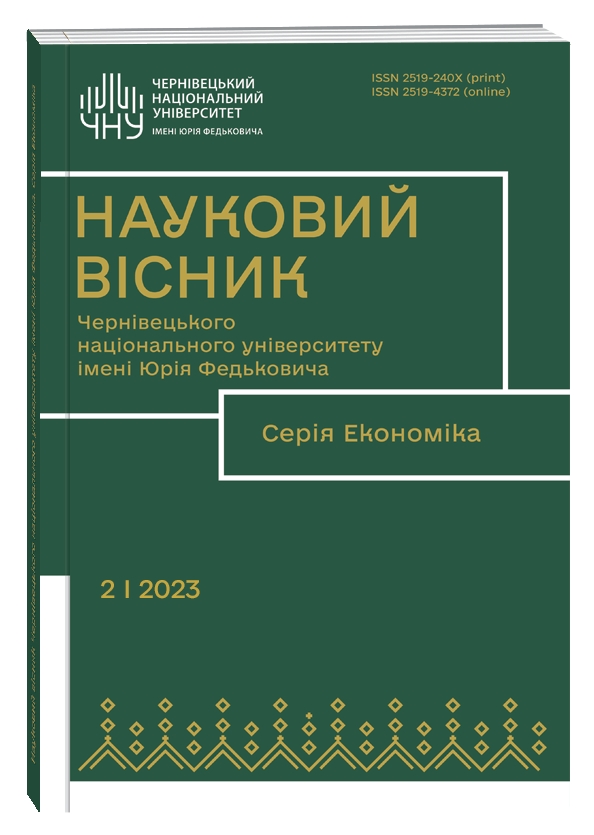INCREASING OF THE INNOVATION AND INVESTMENT POTENTIAL OF ENTERPRISES: FISCAL COMPONENT
DOI:
https://doi.org/10.32782/ecovis/2023-2-9Keywords:
investments, innovations, innovation and investment potential, taxation optimization, financial and economic condition, indicators of financial and economic conditionAbstract
The article reviews and summarizes existing approaches to defining the concept of optimizing enterprise taxation, the optimal tax system, and proposes principles for studying the impact of taxes on the financial and economic status of an enterprise and increasing the innovation and investment potential of enterprises. It has been established that the financial and economic status and innovation and investment potential of an enterprise are significantly influenced by taxation. Approaches to determining optimal tax rates are considered. It has been determined that optimizing the tax system does not consist in adjusting and changing the general tax rate, but in harmonizing the structure of the tax system in order to create the foundations for improving the financial and economic status and innovation and investment potential of the enterprise. The optimal tax system should be defined as a system that simultaneously provides the necessary level of budget revenues and provides opportunities and incentives for the development of the state economy, provides opportunities and stimulates the increase in the innovation and investment potential of enterprises. The concept of "taxation optimization" from this macroeconomic point of view should be defined as a set of actions and measures aimed at achieving an optimal state of the taxation system and the state economy at the macro and micro levels. The main indicators of the financial and economic condition and innovation and investment potential of the enterprise, which are under the influence of the tax burden, are considered. Approaches to the analysis of the impact of taxation on the financial and economic condition and innovation and investment potential of the enterprise are summarized based on management accounting data on the income and expenses of the enterprise. It is determined that statistical and financial data of enterprises, structured in an appropriate manner, provide sufficient information for conducting research on the impact of taxation on the financial and economic condition and innovation and investment potential of the enterprise. The generalizations of concepts, approaches, systems of indicators and ways presented in this article can be the basis for further thorough analysis of the impact of various types of taxes on the financial and economic condition and potential of enterprises and identification of ways to optimize taxation in order to improve the financial and economic condition of enterprises and increase the innovation and investment potential of enterprises.
References
Зайцев О. В. Податковий менеджмент : підручник. Суми : СумДУ, 2017. 412 с.
Кир`язова Т. О., Чулак Н.І. Податкові пільги: проблеми застосування та напрями їх вирішення. Економіка. Фінанси. Право. 2018. № 1. С. 16–23.
Кміть В. М. Оптимізація та мінімізація податків в системі фінансового управління суб’єктів господарювання. Молодий вчений. 2016. № 1 (28). С. 65–69.
Новіков М.А. Порівняльний аналіз методик визначення податкового навантаження та шляхи їх удосконалення. Сталий розвиток економіки. 2019. № 2. С. 284–288.
Лондар С.Л. Модулювання параметрів взаємодії податкової системи з економічним середовищем. Регіональна економіка. 2002. № 1. С. 219–227.
Луніна І. Податкова політика України у контексті створення умов для економічного зростання. Економіка України. 2000. № 9. С. 37–47.
Тимощук М. Індикативне планування на мікрорівні. Регіональна економіка. 2004. № 1. С. 210-216.
Фіщук О. Формування системи економічних індикаторів регіонального розвитку підприємництва. Регіональна економіка. 2000. № 4. С. 111–118.
Colin Drury. (2011) Cost and Management Accounting : textbook. 7th edtion. Cengage Learning EMEA, 504 p.
Zaitsev O. V. (2017) Podatkovyi menedzhment : pidruchnyk [Tax management: textbook]. Sumy : SumDU, 412 p. (in Ukranian).
Kyr`iazova T. O., Chulak N.I. (2018) Podatkovi pilhy: problemy zastosuvannia ta napriamy yikh vyrishennia [Tax benefits: problems of application and directions of their solution]. Ekonomika. Finansy. Pravo - Economics. Finance. Law, vol. № 1, pp. 16–23.
Kmit V. M. (2016) Optymizatsiia ta minimizatsiia podatkiv v systemi finansovoho upravlinnia subiektiv hospodariuvannia [Optimization and minimization of taxes in the financial management system of business entities]. Molodyi vchenyi - Young scientist, Vol № 1 (28), pp. 65–69.
Novikov M. A. (2019) Porivnialnyi analiz metodyk vyznachennia podatkovoho navantazhennia ta shliakhy yikh udoskonalennia [Comparative analysis of methods for determining the tax burden and ways to improve them]. Stalyi rozvytok ekonomiky - Sustainable development of the economy, № 2, pp. 284–288.
Londar S. L. (2002) Moduliuvannia parametriv vzaiemodii podatkovoi systemy z ekonomichnym seredovyshchem [Modulation of the parameters of the interaction of the tax system with the economic environment]. Rehionalna ekonomika – Regional economy, № 1, pp. 219–227.
Lunina I. (2000) Podatkova polityka Ukrainy u konteksti stvorennia umov dlia ekonomichnoho zrostannia [Tax policy of Ukraine in the context of creating conditions for economic growth]. Ekonomika Ukrainy – Economy of Ukraine, № 9, pp. 37–47.
Tymoshchuk M. (2004) Indykatyvne planuvannia na mikrorivni [Indicative planning at the micro level]. Rehionalna ekonomika – Regional economy, №1, pp. 210–216.
Fishchuk O. Formuvannia systemy ekonomichnykh indykatoriv rehionalnoho rozvytku pidpryiemnytstva [Indicative planning at the micro level]. Rehionalna ekonomika – Regional economy, №4, pp. 111–118.
Colin Drury. (2011) Cost and Management Accounting : textbook. 7th edtion. Cengage Learning EMEA, 504 p.



